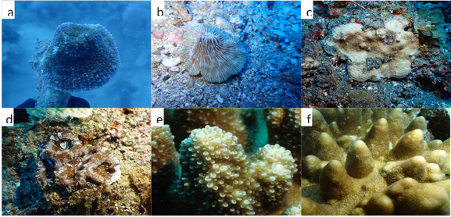Author: Andrew Baird
Prof Andrew Baird, of James Cook University, Australia, a Japan Society for the Promotion of Science (JSPS) alumni, joined Dr James Reimer and members of the Molecular Invertebrate Systematics and Ecology (MISE) Laboratory of the University of the Ryukyus, Japan and Drs Michael Stat and Megan Huggett of the University of Newcastle, Australia, in the Ogasawara Islands in October 2023. After a shortened trip due to a covid infection in 2022, the team got to enjoy a full 10 days in the Islands, getting to sea for four full days on the Hiyu-maru, and some of the best diving any of the team have ever experienced. The reefs were wonderful, with a different coral assemblage at almost every site visited, spectacularly clear waters and some great topography including one extraordinary site “The Crack”: a sea-cave with vertical walls to a depth of up to 18 m that extends about 100 m into the heart of the island. As you swim into the Crack the coral assemblage shifts from zooxanthellate- to azooxanthellate-dominated and ends in almost total darkness. The team dived sites on all points of the compass in the Chichi-jima group, including a few sites on the east coast that are often difficult to access due to oceanic swells. The reefs were remarkably healthy; there were few signs of disease beyond the odd colony with white syndrome, only saw one individual of the corallivores sea-star Acanthaster sp. and few of the corallivorous gastropod Drupella spp. There was little evidence of typhoon damage at the sites we visited as well. The coral assemblages in some parts of the harbour on Chichi-jima have clearly changed: at some sites there were piles of rubble of dead staghorn corals with no sign of living thickets. Nonetheless, there were some interesting sites in the harbour, with a few deeper water Acropora spp. that were not seen elsewhere.
In total we collected approximately 220 samples and our preliminary estimates are that these represent about 180 different species. We recorded a number of species for the first time in the Islands. These include: Diaseris cf. fragilis; Echinomorpha nishihirai; Homophyllia cf. bowerbanki; Pocillopora cf. acuta; Cycloseris cf. wellsi; Cyphastrea cf. agassizi; Acropora pinguis, A. papillare; Dipsastraea cf. helianthoides; Acanthastrea cf. pachysepta and Hydnophora cf. microconos (Fig. 1). Many of the species we collected are likely to be undescribed, in particular, at least one Galaxea sp.; a few of the Acropora spp. and many of the Montipora spp. The mythical Boninastrea boninensis, once again eluded us, supporting its recently listing as extinct by The Ministry of the Environment in Japan. We also found no true staghorn species, despite previous lists including a number of these species. The fact we didn’t record any staghorn species suggests that we missed some habitats.

Photo credits: (a) & (b) Stephane De Palmas; (c)-(f) Andrew Baird.
The coral fauna has some affinities with that of Kyushu (A. japonica; A. tanegashimensis) and the Ryukyus (eg A. akajimensis; A. cf. affinis). Interestingly, none of our sites were Acropora-dominated, which is very unusual for Indo-Pacific localities. Galaxea and Fimbriaphyllia were very common at many sites and at most depths. Cyphastrea also appears to be particularly diverse in the Ogasawara Islands. Our preliminary assessment is that previous estimates of coral species richness are accurate, however, the distinctiveness and proportion of endemics in the fauna have been greatly underappreciated.
A definitive species list will be a few years away and dependent on finding funding to sequence the specimens. Confirmation of the taxonomic identity of the specimens is also contingent on the results of other ongoing projects, such as the Japan topotype project, partially funded via a JSPS Long-term Visiting Fellowship to Andrew Baird in 2022.
Acknowledgements
We thank Sagawa-san, the intrepid captain of Hiyu-maru for looking after us all while at sea and sharing his incredible knowledge of the reefs of the Ogasawara Islands, and JSPS.